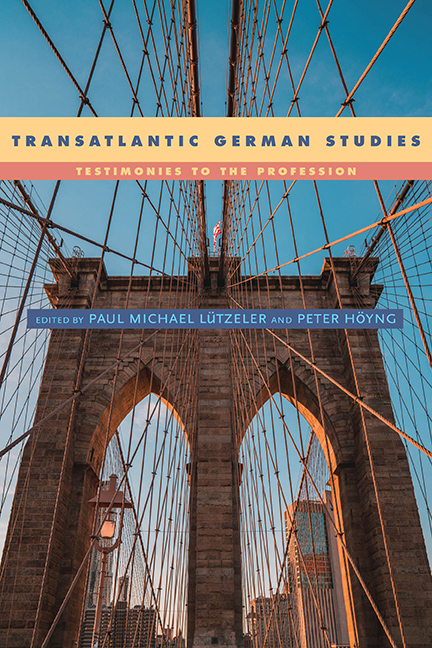Book contents
- Frontmatter
- Dedication
- Contents
- Acknowledgments
- Introduction
- From Erfahrungshunger to Realitätshunger: Futurity, Migration, and Difference
- In-between: The Participant as Observer—The Observer as Participant
- Transatlantic Space and My Own History of Globalization
- Deplazierte Personen: Why Would an American Become a Germanist?
- Metamorphoses and Meanderings of a Wanderer between Worlds
- German Studies as Vocation: My Path into It, Out of It, and Back into It
- My Long Way from Germanistik to Afro German Studies
- Mustang Red: My American Road to Critical Theory
- Third Place: How a French Germanist Became an Applied Linguist in America
- Transatlantic Exchanges: German Studies—European and American Style
- Being at Home in the Other: Thoughts and Tales from a Typically Atypical Germanist
- After Australia: Triangulating an Intellectual Journey
- A Tale in Translation: An Academic Itinerary from Istanbul to Bryn Mawr
- Beyond Passing: Transculturation in “Contact Zones”
- Far from Where? Germanistik between the Continents
- Epilogue: The Usefulness of Useless Studies
- Index
Transatlantic Exchanges: German Studies—European and American Style
Published online by Cambridge University Press: 14 February 2019
- Frontmatter
- Dedication
- Contents
- Acknowledgments
- Introduction
- From Erfahrungshunger to Realitätshunger: Futurity, Migration, and Difference
- In-between: The Participant as Observer—The Observer as Participant
- Transatlantic Space and My Own History of Globalization
- Deplazierte Personen: Why Would an American Become a Germanist?
- Metamorphoses and Meanderings of a Wanderer between Worlds
- German Studies as Vocation: My Path into It, Out of It, and Back into It
- My Long Way from Germanistik to Afro German Studies
- Mustang Red: My American Road to Critical Theory
- Third Place: How a French Germanist Became an Applied Linguist in America
- Transatlantic Exchanges: German Studies—European and American Style
- Being at Home in the Other: Thoughts and Tales from a Typically Atypical Germanist
- After Australia: Triangulating an Intellectual Journey
- A Tale in Translation: An Academic Itinerary from Istanbul to Bryn Mawr
- Beyond Passing: Transculturation in “Contact Zones”
- Far from Where? Germanistik between the Continents
- Epilogue: The Usefulness of Useless Studies
- Index
Summary
A Boy Likes to Go to School
I GREW UP IN THE VILLAGE of Doveren on the German-Dutch border where the German state of North Rhine-Westphalia neighbors the province of Limburg in the southeastern part of the Netherlands. The good people of Doveren were proud of their history, dating as far back as to the Celts and Romans; and during the migration of nations, the Germanic Franks moved into the area to mix with the Gallo-Romanic population. In medieval times the regions on both sides of today's border shared the same ruler, the same dialect, and the same Catholic religion. While the ruling dynasties changed over the centuries, what remained as a dominant force was the influence of the Catholic Church, even after the Congress of Vienna in 1815 decided that the larger western part of the area between the Maas and the Rhine would join the Calvinist Netherlands and that the smaller eastern part would become part of Protestant Prussia. The influence of the Catholic Church was stronger than that of political allegiances or ideologies. When I was growing up there, the religious impact on all aspects of life was still substantial.
As a youngster in the 1950s I found both church and school instruction attractive. The church services contributed to a primary identity formation, and our village school offered us keys to a good number of gates leading to various fields of knowledge. Most of the teachers as well as the priest were refugees, city folk from towns in East Prussia, Silesia, or the Sudetenland, and their German sounded distinctly different from that of the “natives.” We liked their accents and, at the same time, made fun of them by imitating their sounds and gestures. The Doveren people understood only too well what it meant to be a refugee. Between the summers of 1944 and 1945, all of them had been evacuated to different small towns in central Germany. When they returned, the village looked like a war zone; even the church had been bombed—not by Allied forces but by a retreating German tank commando.
Through the church we learned about the great art works of the Italian Renaissance. Copies of paintings and images of statues and buildings by Perugino, Raphael, Michelangelo, and Leonardo circulated in all the church-related publications.
- Type
- Chapter
- Information
- Transatlantic German StudiesTestimonies to the Profession, pp. 160 - 180Publisher: Boydell & BrewerPrint publication year: 2018

